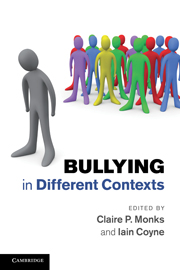Book contents
- Frontmatter
- Contents
- List of figures
- List of tables
- Notes on contributors
- 1 A history of research into bullying
- 2 Peer-victimisation in preschool
- 3 Bullying in schools: thirty years of research
- 4 Peer violence in residential children's homes: a unique experience
- 5 Domestic violence: bullying in the home
- 6 Juvenile dating and violence
- 7 Bullying in prisons: bringing research up to date
- 8 Bullying in the workplace
- 9 Elder abuse and bullying: exploring theoretical and empirical connections
- 10 Cyberbullying
- 11 An overview of bullying and abuse across settings
- Index
- References
8 - Bullying in the workplace
Published online by Cambridge University Press: 05 June 2012
- Frontmatter
- Contents
- List of figures
- List of tables
- Notes on contributors
- 1 A history of research into bullying
- 2 Peer-victimisation in preschool
- 3 Bullying in schools: thirty years of research
- 4 Peer violence in residential children's homes: a unique experience
- 5 Domestic violence: bullying in the home
- 6 Juvenile dating and violence
- 7 Bullying in prisons: bringing research up to date
- 8 Bullying in the workplace
- 9 Elder abuse and bullying: exploring theoretical and empirical connections
- 10 Cyberbullying
- 11 An overview of bullying and abuse across settings
- Index
- References
Summary
For those interested in workplace bullying, it is difficult to conceive that attention and systematic investigation into this topic is relatively recent. However, before the late 1980s, research tended to be anecdotal and awareness was minimal. Since then, interest in the topic has increased rapidly. From an initial focus in Scandinavia (e.g. Björkqvist et al., 1994; Leymann, 1996), workplace bullying is studied globally, in Africa (Marais-Steinman, 2003), Asia (Seo and Leather, 2008), Australia (e.g. Djurkovic et al., 2005), Europe (e.g. Hoel et al., 2001; Nielsen et al., 2009), North America (e.g. Ferris, 2004; Lutgen-Sandvik et al., 2007) and South America (De Souza and De Souza, 2008).
As well as advancing a global perspective on bullying, research techniques and methodologies have also become more varied. Understandably dominated early on by large-scale prevalence surveys, increasing use of different quantitative and qualitative approaches has methodologies showing an ensured more systematic research that has rapidly changed our understanding of this complex phenomenon. Although no one can claim to have solved the problem, researchers, practitioners and other stakeholders are becoming increasingly aware of what workplace bullying is and how it can be managed.
This chapter aims to provide readers with an outline and discussion of the research and practice relating to workplace bullying as it currently stands. The intention is to discuss the advances made in theory and practice, highlight areas for future development and consider the development/evaluation of interventions to reduce workplace bullying.
- Type
- Chapter
- Information
- Bullying in Different Contexts , pp. 157 - 184Publisher: Cambridge University PressPrint publication year: 2011
References
- 10
- Cited by

